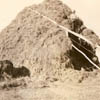Labour
 The farming communities south of Stettler and north of Big Valley were soon to be known as the Linda Hall district. Estonian settlements were spread out across Alberta's sweeping prairies. The farms were roughly 10 miles south of Stettler, bordered by the shores of Lone Pine Lake and extending south-southwest in the vicinity of the Red Deer River. The area was largely settled between 1903 and 1909.
The farming communities south of Stettler and north of Big Valley were soon to be known as the Linda Hall district. Estonian settlements were spread out across Alberta's sweeping prairies. The farms were roughly 10 miles south of Stettler, bordered by the shores of Lone Pine Lake and extending south-southwest in the vicinity of the Red Deer River. The area was largely settled between 1903 and 1909.
The Estonians arrived with only the clothes on their backs, household goods, and garden seeds-enough to start subsistence farming for the first couple of years. More importantly, they brought their customs, language, and traditions. As soon as possible, an Estonian family would purchase a draft animal from a nearby neighbour. This was a welcome addition to any pioneer farming community. Oxen allowed quicker access to the commerce available in Red Deer. For instance, a single trip using a cart and oxen could return a winter's supply of food and materials whereas if one travelled by foot, several trips were needed to achieve the same end.
 The Estonians were keen on fostering a sense of community and helped their neighbours whenever possible. Community projects to build log houses were undertaken, and the sharing of draft animals was common. Each Estonian settler applied his or her skills to improving the community as a whole. For example, a man named Reinglas was a harness-maker and served the needs of his community until he departed for Australia. Another settler named Roon built a small flour mill from two suitable grinding stones found on his property.
The Estonians were keen on fostering a sense of community and helped their neighbours whenever possible. Community projects to build log houses were undertaken, and the sharing of draft animals was common. Each Estonian settler applied his or her skills to improving the community as a whole. For example, a man named Reinglas was a harness-maker and served the needs of his community until he departed for Australia. Another settler named Roon built a small flour mill from two suitable grinding stones found on his property.
During the early part of the 20th century, many pioneer families had to overcome the challenge of obtaining potable water. Typically, wells were dug to access clean water. A shovel was the tool of choice in creating a large hole four feet wide and four feet long. Usually, if the labourer was fortunate, he/she discovered water at a depth of only 20 to 30 feet deep. A rope, bucket, and pulley system was implemented to remove loose soil as the digging process ensued. Creating wells was a necessary but dangerous task with labourers often running the risk of having the well cave in while they were digging beneath the surface.








